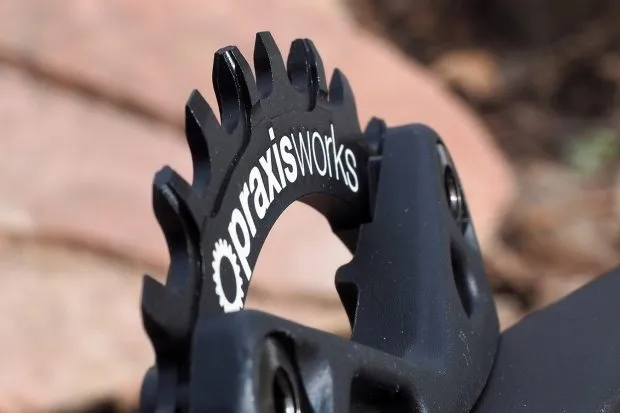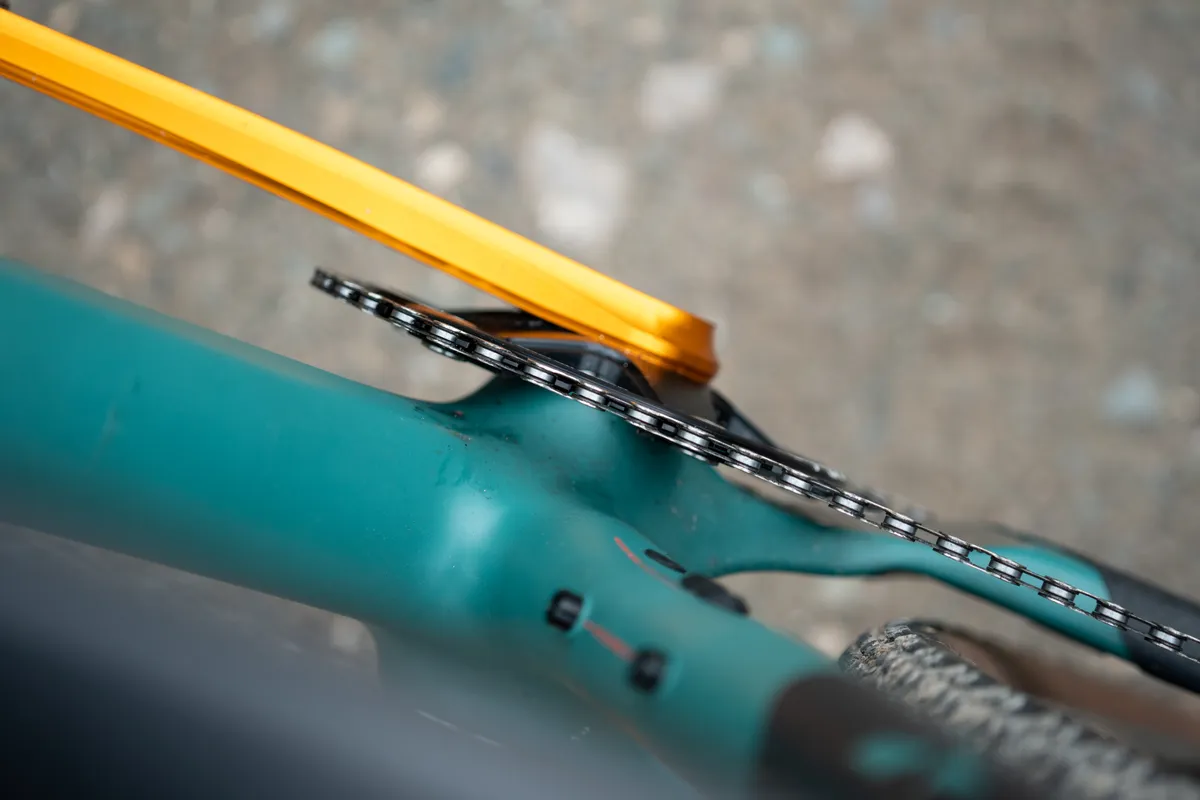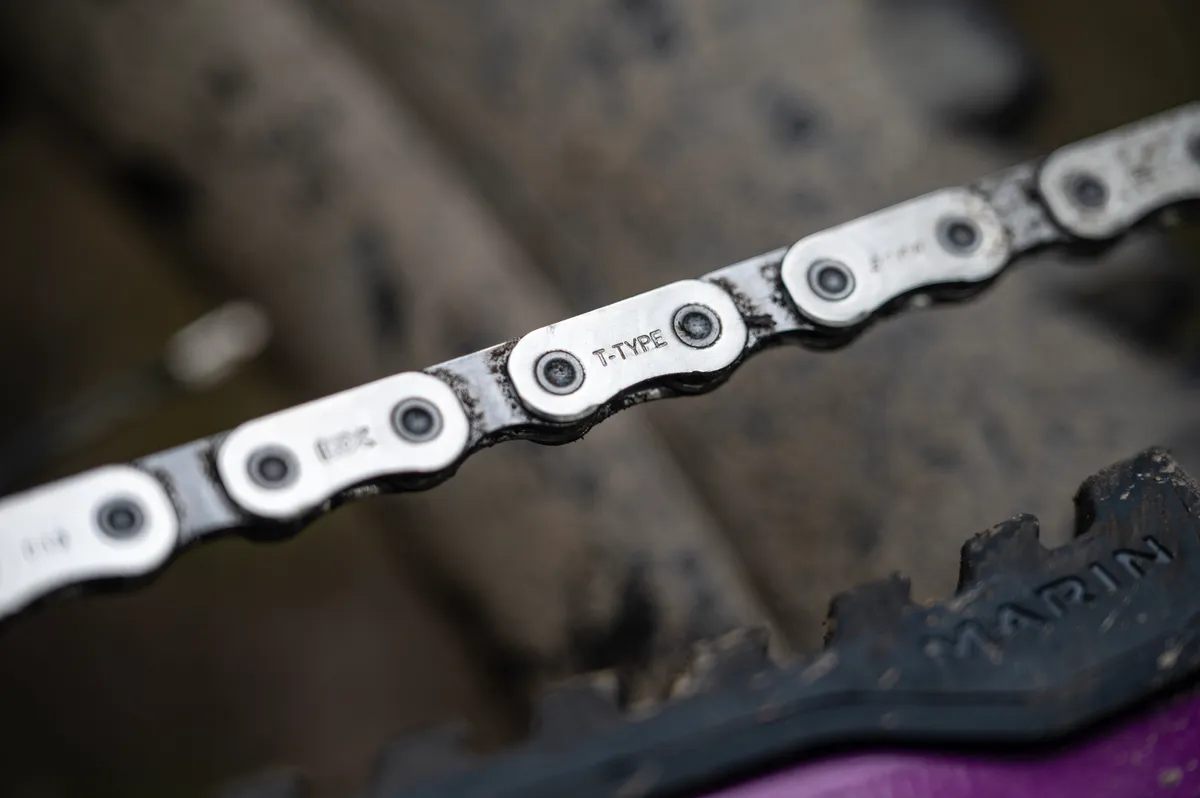A narrow-wide chainring is a chainring with specially designed teeth intended to improve chain retention of 1x drivetrains.
As the name suggests, narrow-wide chainrings have teeth of alternating profiles, which are designed to mesh with the profile of the chain.
Narrow-wide chainrings are incorporated into 1x-specific groupsets for both road bikes and gravel bikes. They are also available aftermarket for those converting to a single-chainring drivetrain.
What is a narrow-wide chainring?

Before we dive into how a narrow-wide chainring works, we first need to understand the problems it addresses.
Bicycle chains consist of two types of links: the inner link and the outer link.
Every second link is a wider outer link, and in between them sits a narrower inner link.
The space between the sides of the inner link is noticeably narrower than the space between the sides of the outer links.
Conventional chainrings (including those used in multi-chainring drivetrains) use the same tooth width across the entire chainring.
The teeth are designed to fit the narrower inner links only, which means every second tooth (which corresponds to the wider outer links) barely contacts the chain at all.

Over rough ground, or at a high cadence, this lack of contact between the chain and the chainring can cause the chain to bounce or slip off the chainring teeth, causing it to drop.
Narrow-wide chainrings use an alternating narrow/wide tooth profile that matches (or meshes with) the inner and outer links of a chain. This prevents excessive lateral movement and guides the alignment of every link it’s in contact with.
This means every link has a secure connection to the chainring and should prevent dropped chains from disrupting your ride.
Are there any drawbacks?

Narrow-wide chainrings vastly improve chain retention without creating excess drag.
However, due to the tight fit between the chainring teeth and the chain links, it’s important to make sure you clean your chain and chainring. Grime and dirt can prevent the system from working properly or increase chain wear.
It’s also important to keep on top of chainring wear because worn tooth profiles on a narrow-wide chainring can have a detrimental effect on the system’s chain retention.
Additionally, a worn tooth profile can lead to chain suck, where the chain fails to disengage from the chainring at the end of the rotation (though this is also true of conventional chainrings).
Narrow-wide chainring sizes

Narrow-wide chainrings come in a range of sizes.
For mountain bikes, they typically range in size from 28 to 36 teeth. The most common size for mountain bike drivetrains tends to be 32t.

Narrow-wide chainrings for road or gravel bikes are available in a much larger range of sizes – it's not uncommon to see narrow-wide 1x chainrings designed for time-trial racing as large as 60t, for example.
Due to the alternating thick/thin tooth profile, narrow-wide chainrings are only available with an even number of teeth.
Narrow-wide chainring chain compatibility explained

Before you buy a narrow-wide chainring, it’s important to check whether the model you are looking at has the correct tooth profile to work with your chain and drivetrain.
Wolf Tooth, for example, offers its narrow-wide Drop-Stop Chainring in three tooth profiles. These are designed to fit specific chains from different manufacturers.
Narrow-wide chainrings are also available to suit different 'speed' drivetrains. For example, a 9-speed chain is wider than a modern 12-speed chain, so it requires a different profile of narrow-wide teeth for the best performance possible.
Narrow-wide chainring fitting standards

Chainrings are mounted to a crankset in two ways.
The first is via a spider, which is usually (but not always) an integral part of the crank. The spider is another name for the arms that protrude from the centre of a cransket.
Most modern road and mountain bike crank arms have four-arm spiders. Older models will generally have five arms.
These arms differ in size and determine the size of chainring you can fit to your crankset. The spacing between the mounting holes on these arms is called the 'Bolt Circle Diameter'. This is the diameter of an imaginary circle drawn through the centre of all the bolts on your chainring.
Modern Shimano mountain bike crank arms have an asymmetrical 64mm BCD. Older cranks may have a 5-arm 110mm or 58mm BCD.
Some chainrings will have their BCD engraved on them, which makes finding a replacement easy.
If you don’t know the BCD of your four- or five-bolt chainring, you will have to measure it yourself – we recommend Sheldon Brown's guide on how to measure BCD.

Direct-mount cranksets do without the spider, with the chainring instead mounting onto a usually splined pattern on the crankset.
Direct-mount cranksets are used by brands such as SRAM, Shimano, Race Face and others.
Generally, direct-mount cranksets are lighter than their spider counterparts. They also allow for smaller chainring sizes.
With direct-mount cranksets, the crank-to-chainring interface is often specific to a brand. So, if you’re looking for a narrow-wide chainring for a direct-mount crankset, you will have to make sure your new chainring is compatible with the splines and grooves of the crank.
This can limit the options available to you, depending on how many chainrings fit your specific crankset.
Note that some cranksets (eg, Middleburn) offer the option of mounting a direct-mount spider, onto which different chainrings can be mounted.
